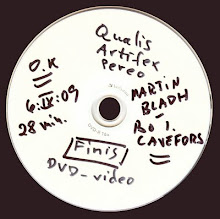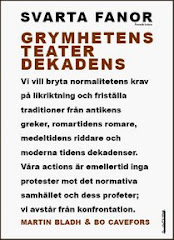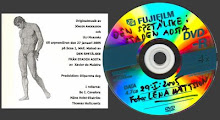10.08.2009
Johannes Flink's interview with Bo I. Cavefors for Tidningen Kulturen
Johannes Flink’s interview with Bo for Tidningen Kulturen.
For decades on end Bo Cavefors was, by far, Sweden’s foremost alternative publisher. As a publisher, his attitude was one of curiosity and fearless exploration, expressed in the long list of radical titles (including Mao, Nietzsche, Jünger, Dali, Lautréamont, Marx, Pound, Pasolini, etc.) edited at his Bo Cavefors Bokförlag. His own magazine Svarta Fanor (Black Flags), along with his parallel German and Swedish edition of the texts of the Red Army Fraction, remain unique and unsurpassed events in a publishing climate otherwise marked by complacence and cowardice. Educated by the Jesuits in England and ever an engaged catholic, Cavefors has constantly perceived matters from an international perspective vastly divergent from the provincial concerns prevalent in Swedish culture. Always siding with the intellect against power, always longing for transgression, he remained in some ways marginal despite the magnitude of his contribution to the Swedish book-publishing scene. However, for those of us who agree that the duck-pond is too small for our spirits, Cavefors will always remain a key figure of Swedish radicalism.
Arousing somewhat less attention, so far, is Bo’s series of short memoir books (even if they are gradually acknowledged by the critics) and the performance art he has developed over the last few years. For this reason, I wanted to ask him some questions about these subjects and to give him a chance to explain his own artistic development to a wider audience. I wanted to put his history as a publisher to the side for a while, to focus instead on the man, the author and the artist Bo Cavefors, and to ask him about his present … and his future …
Welcome Bo Cavefors! My first question is simply what you are doing right now? What I’m after, however, is not just a definition of your present activities. Rather, I would like to know if you are sensing a definitive direction in your artistic development, and, if so, a direction from what beginning to what end? What is it that you hope to explore by your recent and present activities?
Over the last years, I have clearly noted a return to my all-embracing, adolescent pre-occupations from … let’s say from my teenage years and up to my thirties. And this applies both to my writing – where it is specifically obvious in my three plays Rebellion in the Kasbah, Sade and the Japanese and The Leper in Aosta – and to the films I have written, acted out and produced in collaboration with Martin Bladh. My interest in the theatrical mode of presentation, in speech and acting as they are performed on a stage, emerged during my school years. I did my first performance in the first grade, in my Latin school in Malmö, when I was asked to read my home assignment to the rest of the class. It was a relief to suddenly stand there in front of the others and feel that they actually had to listen to what I had to say ... I guess it gave me the childish kick of manipulation… And the thing went on...>>>> CONT.>>>>>>>
8.25.2009
QUALIS ARTIFEX PEREO - FINIS

+
+
+
Martin Bladh and Bo I. Cavefors
QUALIS ARTIFEX PEREO - FINIS
Action: Johan Adolphi, Martin Bladh, Bo I. Cavefors and Mikael Oretoft
Photo: Peter Andersson and Lars Bosma
Music: Martin Bladh and Erik Jarl
Produced 12th June 2009 in Norrköping, Sweden
Published as a dvd together with QUALIS ARTIFEX PEREO (Aryan Kaganof) 2009-2010

8.24.2009
8.23.2009
dionysos andronis : qualis artifex pereo

July 11, 2008
“QUALIS ARTIFEX PEREO” (2008) – un film de Aryan Kaganof
Ayant filmé cette performance actionniste suédoise, Aryan Kaganof récidive encore une fois dans le domaine de l’art corporel, qui est son domaine de prédilection depuis très longtemps. Ses anciens films classiques des performances jusqu’au-boutistes de Ron Athey, filmés dans les années 90 également par lui, ce sont des preuves de son obsession par cette discipline importante de l’art contemporain.
La performance filmée d’une manière très poétique par Kaganof est celle de Bo Cavefors, un père de l’art corporel suédois, qui a eu lieu en juin 2008 à Malmo. Elle s’intitule «Action numéro 43 » et elle est dans l’esprit de ses actions précédentes. Bo Cavefors est allongé par terre au début du film. Un zoom out de son visage est le point de départ de l’action. Le film est conçu comme un triptyque, à la manière d’une autre performance du même artiste. Elle a eu lieu en 2007 à Stockholm et elle était intitulée «Trois études sur une crucifixion », d’après la même œuvre de Francis Bacon.
Pendant la première séquence du film «Qualis Artifex Pereo » on voit trois actants autour de Cavefors, qui est l’actant central. Deux femmes et un homme l’observent silencieusement en train de se masturber et de se préparer lentement pour le point culminant de la troisième séquence. Pendant que Johanna Rosenqvist récite en suédois les vers magiques de «L’Anus Solaire » de Georges Bataille, Cavefors se caresse et commence des fellations avec l’homme Martin Bladh. Des mouvements voyeuristes de la caméra sur les parties de son corps et des autres actants deviennent insistants et excitants. L’extrait récité a été écrit en 1931 et ça commence ainsi:
«Quand j’ai le visage injecté de sang, il devient rouge et obscène.
Il trahit en même temps, par des réflexes morbides, l’érection sanglante et une soif exigeante d’impudeur et de débauche criminelle.
Ainsi je ne crains pas d’affirmer que mon visage est un scandale et que mes passions ne sont exprimées que par le Jésuve.
Le globe terrestre est couvert de volcans qui lui servent d’anus.
Bien que ce globe ne mange rien, il rejette parfois au-dehors le contenu de ses entrailles.
Ce contenu jaillit avec fracas et retombe en ruisselant sur les pentes du Jésuve, répandant partout la mort et le terreur » (op.cit, repris dans «Œuvres Complètes » éditions Gallimard, Paris, 1970, page 85).Cette première séquence de préparation fait 25 minutes. Les textes de Martin Bladh suivent celui de Bataille, toujours récités par Rosenqvist. Tout au long du film il y a une musique discrète composée par l’actant Martin Bladh, le même compositeur stable des performances anciennes de Cavefors. A noter aussi que c’est le même Bladh le traducteur en suédois des extraits de Bataille.
La deuxième séquence fait 5 minutes et on y voit Cavefors et Rosenqvist en train de préparer leur partition au bureau, habillés comme tous les jours. La troisième serait, d’une certaine façon, le point culminant du plaisir puisque pendant cette partie du film la deuxième femme introduit ses talons dans le cul de Cavefors pendant que la musique devient plus aigue et monotone. 40 minutes est la durée totale de ce film – triptyque extraordinaire.
Le titre latin signifie “quel artiste meurt ” et ce sont les derniers mots de l’empéreur Néron avant de se suicider. Avec ce choix de titre, Kaganof aimerait nous rappeler que toutes les créations artistiques importantes se basent sur la passion folle, celle qui conduit à la mort.
dionysos andronis
aryan kaganof : transgression axiom for bo cavefors
photographer: aryan kaganof
8.22.2009
qualis artifex pereo
'



african noise foundation
in association with
grymhetens teater dekadens
present
"qualis artifex pereo"
("oh what an artist the world loses in me" emperor nero’s dying words upon committing suicide)
an acéphale performance
by
bo i. cavefors, johanna rosenqvist, martin bladh...
text by georges bataille and martin bladh
music composed by martin bladh
sound engineer mikael oretoft
film aryan kaganof
(40min, HDV, Sweden, june 2008)
Info 1.
Info 2.
Info 3.
3.23.2009
Bo I. Cavefors : Die Toteninsel - Dödens Ö / Libretto

Bo I. Cavefors
DÖDENS Ö
Libretto och scenanvisningar:
Bo I. Cavefors
Musik: X
Scen: Arnold Böcklins målning Die Toteninsel (den första versionen, 1880). Målningen projiceras på en duk som täcker hela scenens fond.Framför målningen, med ryggen mot publiken en vitklädd figur (=den vitklädda figuren i båten på Böcklins målning). Iklädd en vit tunn mantel som är öppen framtill. Publiken ser inte att figuren är naken, om det är man eller kvinna, förrän mot föreställningens slut då han/hon vänder sig mot publiken. Rösten bör inte avslöja om det är man eller kvinna som framför texten. Alternativ 1: Naken man med androgynt utseende; alternativ 2: naken kvinna med pojkaktigt utseende. Spelas alternativ 2 måste texten ändras på några få ställen.
Scengolvet täckes av nakna män och kvinnor som kopulerar, smeker varandra, män med män, kvinnor med kvinnor, under hela föreställningen liggande på golvet, då och då hörbart, som kyssar, rop, suckanden. Vällust. Smärtskrik. Över dessa män och kvinnor ett blåsvart ljus som ger intryck av hav. Kropparna rör sig som vågor. Koreografi.
+ + +
Sapfo, när du dog
Blev allt det som var du
Förgängligt.
Du dog
Medan du levde.
Du är död död död.
Du är Döden.
Varför ljuga:
„Wie froh bin ich,
Daß ich weg bin!” 1a)
Vad är ett
Människohjärta? 1b)
Äntligen är
Allt slut.
Inga minnen,
Ingen längtan
Finns kvar
Efter din våta
Vulva
Med deRöda läpparna,
Som reste sig
Som vampyrer
Där borta på ön
Med den ogenomträngliga
Skogen med
Svarta barrtäta träd.
Men vad
Sker mellan män
I trädens skuggor
När du vänder bort
Blicken, Sapfo?
... ... ...
Läs fortsättningen HÄR>>>
Copyright©Bo I. Cavefors, 2009.























